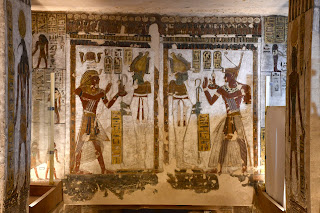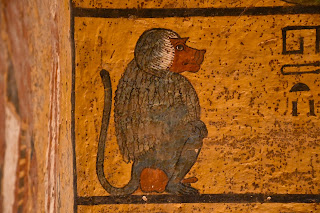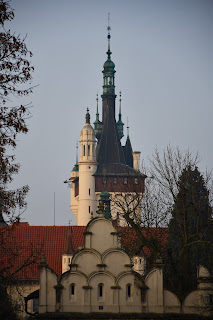An Egyptian Excursion – Day 2: The Theban Necropolis
We began our itinerary at a leisurely eight o’clock in the morning. While the ship remained moored by the pier under Luxor Temple, a small boat took our group to the opposite bank. Imbued with symbolic importance, the western bank of the Nile is home to the Theban Necropolis, a vast collection of royal mortuary temples and necropoleis. This is where, especially during the New Kingdom, pharaohs were laid to rest in ornate tombs covered in carvings and paintings of scenes from sacred funerary texts. Many of the tombs were looted, some of them by subsequent pharaohs looking for extra funds to line their coffers, and their long exposure to the outside atmosphere is why most paintings appear heavily bleached.
We made our
first stop by the Colossi of Memnon. These two giant statues used to guard the
largest temple in the Theban Necropolis, the Mortuary Temple of Amenhotep III.
Little remains of the temple itself beside a few other mostly ruined statues,
but the excavations continue. “Memnon,” I should note, is a misnomer. The
colossi depict Amenhotep III, whom Roman-era travellers identified with
Aethiopian King Memnon from Greek legend. The site dates to 1350 BCE.
From the
Colossi of Memnon, we continued to the Valley of the Kings. Founded in the
sixteenth century BCE, this area was the primary burial site of Egyptian
pharaohs and notable nobles for about five hundred years. Over sixty tombs and
chambers have been discovered in the rock, most of them already looted, but
they have retained the beautiful reliefs that accompanied the dead into the
afterlife. According to what I have heard from other travellers, not all tombs
are accessible at any given time: they alternate to keep the paint from
deteriorating. On our visit, we visited four tombs: the joint tomb of Ramesses
V and VI, and the tombs of Ramesses III, I, and IX, in that order.
I also paid
five dollars extra to see the tomb of Tutankhamun, which the rest of the group
was not interested in. It is much smaller than the other tombs we saw, but
since it was never looted and remained sealed off from the elements, the
frescoes retained their vibrant colours into the modern era. Most people,
however, visit the tomb to look at the mummy of King Tutankhamun, whose magnificent
sarcophagus is now on display in Cairo. Seeing people take selfies with the
dead pharaoh felt inappropriate; I have decided against taking pictures of
mummies and dead people as I find it a bit too morbid. Then again, I recognise
that it is inappropriate to be visiting the tomb in the first place, as though
the passing of time had rendered the Ancient Egyptian vision of the afterlife unworthy
of respect.
Our final
stop of the day – excluding the obligatory layover by an alabaster workshop and
a papyrus shop – was the Mortuary Temple of Hatshepsut. This temple is
particular for its three levels, which form terraces against the face of the
rock. Each level can be easily discerned from afar by its arcades, and the
uppermost arcade is fronted by a number of well-preserved giant statues in
Pharaonic garb and pose. I overheard at Karnak that dead pharaohs are depicted
differently from live ones. The former tend to cross their arms across their
chest and the tip of their beard turns upward. The latter keep their arms along
their sides and are often depicted as stepping out with their left leg.
We returned
to our ship in time for lunch and did not make any land excursions for the rest
of the day. Instead, the ship began its course towards the Temple of Edfu.
Against the barren yellow hills above, I finally perceived the stark contrast
between the verdant banks of the Nile and the desert beyond. I originally
thought I might notice this contrast as we drove into Luxor, but because of
urban sprawl it was difficult to tell where the fertile belt began. The minibus
would occasionally pass a field by the bank of a tributary, but by and large we
mostly watched the scenes unfolding in the streets: tuk-tuks swaying left and
right at top speed, donkeys laden with goods trotting along, and men selling
whole crates of tomatoes by the roadsides.
On our way
from Luxor, however, we could clearly see the palm trees silhouetted against
the cream-coloured cliffs and the lush bushes by the Nile stubbornly clinging
to the ground under the swelling sandy hills. As the sky took on a
yellow-greyish tinge, we reached the dam at Esna. Our ship, which had been
racing ahead all afternoon, finally slowed down to join the queue for the lock
and eventually stopped altogether. When it did so, the boats that had been
following us and occasionally managed to latch onto ours began to circle us.
They belonged
to the Nile’s famous floating vendors: men selling clothes, rags, bags, and
other such items, which they packed into plastic bags and threw above onto the
board. Interested tourists would unpack the bags, glance over the merchandise,
perhaps haggle a little, and then throw down the bags with the rest of the
items and some money, keeping whatever they wanted to buy. When the vendors
felt they were not getting enough attention, they yelled “Ah-lay, ah-lay,
ah-lay,” laying stress sometimes on the first syllable, sometimes on the
second. They seemed to speak a few words in every language they encountered:
English, French, Spanish, and a mishmash of Slavic tongues. They milled around
us for half an hour or so before moving on and I fell asleep by the time we
reached the lock.



























Comments
Post a Comment